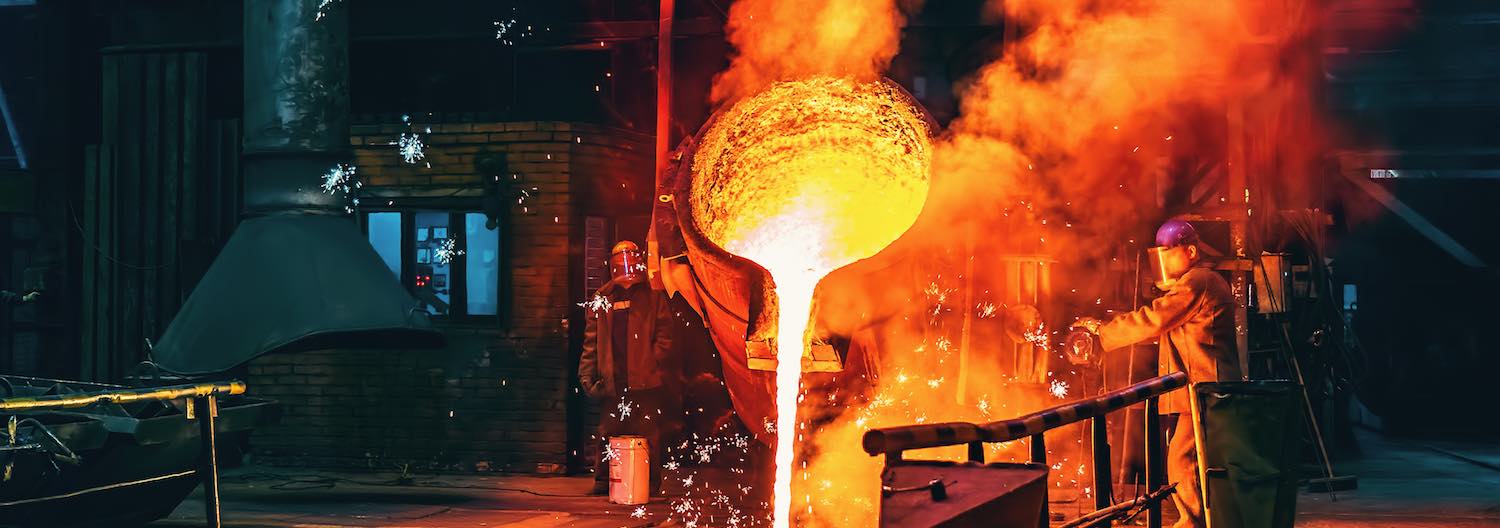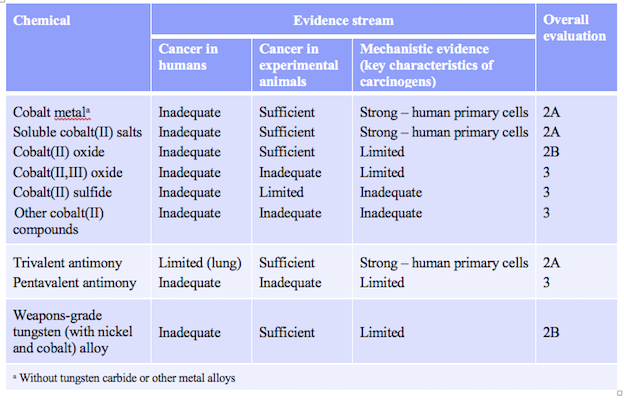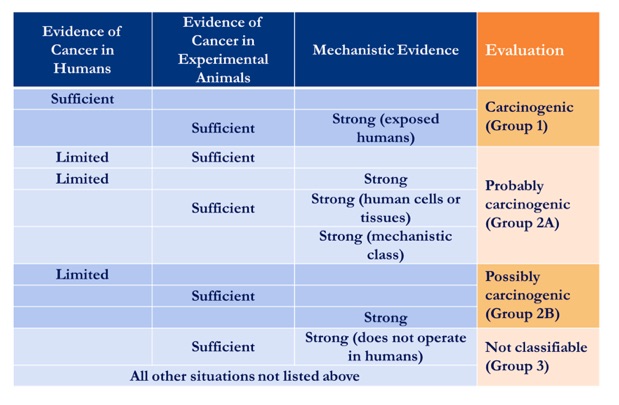More
5 April 2022
IARC Monographs evaluate the carcinogenicity of cobalt, antimony compounds, and weapons-grade tungsten alloy
 IARC Monographs Meeting 131
Home
IARC Monographs Meeting 131
Home
Questions and Answers (Q&A)
The meeting for IARC Monographs Volume 131: Cobalt, Antimony Compounds, and Weapons-Grade Tungsten Alloy, convened by the International Agency for Research on Cancer (IARC) and held remotely due to the coronavirus disease (COVID-19) pandemic, took place on 2–18 March 2022.
The Working Group of international experts, including 31 scientists from 13 countries, evaluated the carcinogenicity of cobalt metal (without tungsten carbide or other metal alloys), soluble cobalt(II) salts, cobalt(II) oxide, cobalt(II,III) oxide, cobalt(II) sulfide, other cobalt(II) compounds, trivalent antimony, pentavalent antimony, and weapons-grade tungsten (with nickel and cobalt) alloy.
More information about the meeting is available on the IARC Monographs website: https://monographs.iarc.who.int/iarc-monographs-volume-131/.
The outcome of the assessment has been published in a summary article in The Lancet Oncology1 and will be described in detail in Volume 131 of the IARC Monographs, to be published in early 2023.
1 Karagas MR, Wang A, Dorman DC, Hall AL, Pi J, Sergi CM, et al. (2022). Carcinogenicity of cobalt, antimony compounds, and weapons-grade tungsten alloy. Lancet Oncol, Published online 7 April 2022; https://doi.org/10.1016/s1470-2045(22)00219-4
1. What are the results of the evaluation?
Cobalt metal (without tungsten carbide or other metal alloys) and soluble cobalt(II) salts were classified as probably carcinogenic to humans (Group 2A) on the basis of sufficient evidence for cancer in experimental animals and strong mechanistic evidence (related to key characteristics of carcinogens in human primary cells and in experimental systems). There was inadequate evidence regarding cancer in humans.
Cobalt(II) oxide was classified as possibly carcinogenic to humans (Group 2B) on the basis of sufficient evidence for cancer in experimental animals. There was limited mechanistic evidence and inadequate evidence regarding cancer in humans.
Cobalt(II,III) oxide was not classifiable as to its carcinogenicity to humans (Group 3). There was inadequate evidence regarding cancer in humans and in experimental animals and limited mechanistic evidence.
Cobalt(II) sulfide was not classifiable as to its carcinogenicity to humans (Group 3). There was limited evidence for cancer in experimental animals, inadequate evidence regarding cancer in humans, and inadequate mechanistic evidence.
Other cobalt(II) compounds were not classifiable as to their carcinogenicity to humans (Group 3). There was inadequate evidence regarding cancer in humans and in experimental animals and inadequate mechanistic evidence.
For cobalt metal, cobalt oxides, and cobalt sulfide, particles of all sizes were included in the evaluation.
Trivalent antimony was classified as probably carcinogenic to humans (Group 2A) on the basis of limited evidence for cancer in humans (for cancer of the lung), sufficient evidence for cancer in experimental animals, and strong mechanistic evidence (related to key characteristics of carcinogens in human primary cells and in experimental systems).
Pentavalent antimony was not classifiable as to its carcinogenicity to humans (Group 3). There was inadequate evidence regarding cancer in humans and in experimental animals and limited mechanistic evidence.
Weapons-grade tungsten (with nickel and cobalt) alloy was classified as possibly carcinogenic to humans (Group 2B) on the basis of sufficient evidence for cancer in experimental animals. There was limited mechanistic evidence and inadequate evidence regarding cancer in humans.
Table 1 Summary of classifications in IARC Monographs Volume 131
2. Have these agents previously been evaluated by the IARC Monographs programme?
Agents previously evaluated by the IARC Monographs programme:
Cobalt metal without tungsten carbide: Group 2B (2003)
Soluble cobalt salts: Group 2B (2003)
Other cobalt(II) compounds: Group 2B (1990)
Trivalent antimony: Group 2B for antimony trioxide (1989); WHO Guideline for drinking-water quality (WHO GDWQ, 2003) tolerable daily intake (TDI) for antimony of 6 μg/kg of body weight
Agents never previously evaluated by the IARC Monographs programme:
Pentavalent antimony
Weapons-grade tungsten (with nickel and cobalt) alloy
3. Who is exposed to these agents, and how?
Cobalt is produced mainly as a by-product of the mining and processing of the ores of other metals. Globally, mining and refinery production of cobalt have increased steadily over the past two decades. Cobalt is used in many industries, including in the manufacture of cutting and grinding tools, in pigments and paints, coloured glass, medical implants, batteries, and electroplating.
Occupational exposure can occur during production of hard metal and cobalt powder, use of cobalt-containing pigments and driers, and production and recycling of lithium-ion batteries.
The general population can be exposed via ambient air, drinking-water, tobacco smoke, and food.
Trivalent antimony is a High Production Volume chemical. Trivalent antimony compounds are used in the production of flame retardants, plastics, lead–acid batteries, lead alloys, glass, pigments, and paints.
Occupational exposure can occur through mining, copper smelting, production of antimony compounds, manufacture and recycling of batteries and electronic waste, and among firefighters.
The general population can be exposed by inhalation of fuel and coal combustion products and road traffic dust, and via drinking-water and consumer products such as toys and cosmetics.
Pentavalent antimony is used mainly in antileishmanial drugs.
Weapons-grade tungsten (with nickel and cobalt) alloy is used in armour-penetrating munitions as a replacement for depleted uranium.
Occupational exposure can occur during the production, firing, or impact of these weapons, and through war-related injury by retained embedded metal fragments.
4. What does the IARC Monographs classification mean in terms of risk?
The IARC Monographs classification indicates the strength of the evidence that a substance or agent can cause cancer. The IARC Monographs programme seeks to identify cancer hazards, that is, the potential for the exposure to cause cancer. However, the classification does not indicate the level of cancer risk associated with exposure at different levels or in different scenarios. The cancer risk associated with substances or agents that are assigned the same classification may be very different, depending on factors such as the type and extent of exposure and the size of the effect of the agent at a given exposure level.
6. What are the four different categories into which agents are classified by the IARC Monographs?
Group 1: The agent is carcinogenic to humans.
This category is used when there is sufficient evidence for cancer in humans. In other words, there is convincing evidence that the agent causes cancer in humans. The evaluation is usually based on the results of epidemiological studies showing development of cancer in exposed humans. Agents can also be classified in Group 1 on the basis of sufficient evidence for cancer in experimental animals supported by strong evidence in exposed humans that the agent has mechanistic effects that are important for cancer development.
Group 2: This category includes agents with a range of evidence regarding cancer in humans and in experimental animals. At one extreme of the range are agents with positive but not conclusive evidence regarding cancer in humans. At the other extreme are agents for which evidence in humans is not available but for which there is sufficient evidence for cancer in experimental animals. There are two subcategories, which indicate different levels of evidence.
Group 2A: The agent is probably carcinogenic to humans.
This category is used in three different scenarios:
- When there is limited evidence for cancer in humans and sufficient evidence for cancer in experimental animals (“limited evidence for cancer in humans” means that a positive association has been observed between exposure to the agent and cancer but that other explanations for the observations, technically termed “chance”, “bias”, or “confounding”, could not be ruled out with reasonable confidence);
- When there is limited evidence for cancer in humans and strong mechanistic evidence;
- When there is sufficient evidence for cancer in experimental animals and strong mechanistic evidence in human primary cells or tissues.
These scenarios may also occur simultaneously within a Group 2A classification (as is the case for trivalent antimony).
Group 2B: The agent is possibly carcinogenic to humans.
This category is used when there is limited evidence for cancer in humans and less-than-sufficient evidence for cancer in experimental animals. It may also be used when the evidence regarding cancer in humans does not permit a conclusion to be drawn (referred to as inadequate evidence) but there is sufficient evidence for cancer in experimental animals or strong mechanistic evidence.
Group 3: The agent is not classifiable as to its carcinogenicity to humans.
This category is used most commonly when the evidence is inadequate regarding cancer in humans and inadequate or limited for cancer in experimental animals, and mechanistic evidence is less than strong. Limited evidence for cancer in experimental animals means that the available information suggests a carcinogenic effect but is not conclusive.
7. How was the evidence reviewed in the IARC Monographs evaluation?
During an IARC Monographs evaluation, experts critically review the scientific evidence according to strict criteria, which focus on determining the strength of the available evidence that the agent causes cancer. These criteria are described in the Preamble to the IARC Monographs, which is available on the IARC Monographs website: https://monographs.iarc.who.int/wp-content/uploads/2019/07/Preamble-2019.pdf.
The experts critically review four types of data:
- the situations in which people are exposed to the agent;
- epidemiological studies on cancer in humans exposed to the agent (scientific evidence regarding cancer in humans);
- experimental studies of cancer in laboratory animals treated with the agent (scientific evidence regarding cancer in experimental animals); and
- studies on how cancer develops in response to the agent (scientific evidence on carcinogen mechanisms).
8. What are IARC’s recommendations based on these results?
IARC is a research organization that evaluates the evidence on the causes of cancer but does not make health recommendations. However, the evaluations made by the IARC Monographs are often used as a basis for national and international policies, guidelines, and recommendations to minimize cancer risks.
You can find more information on the IARC Monographs evaluation process here:
https://monographs.iarc.who.int/wp-content/uploads/2018/07/QA_ENG.pdf.

